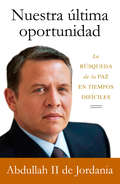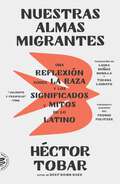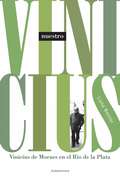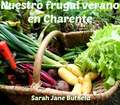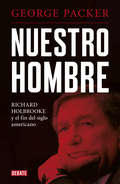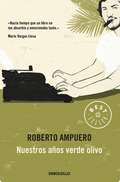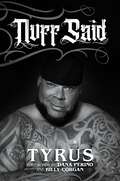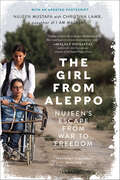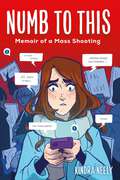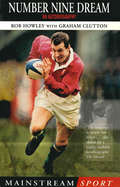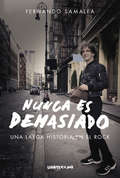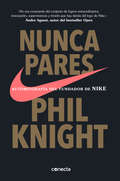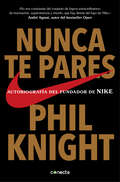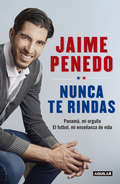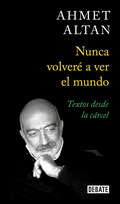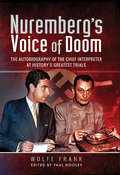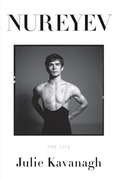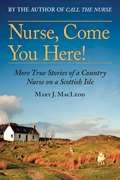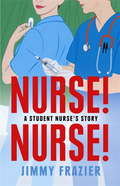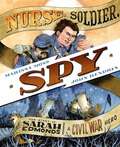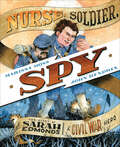- Table View
- List View
Nuestra última oportunidad: La búsqueda de la paz en tiempos difíciles
by King Abdullah IIUnas memorias reveladoras del rey de Jordarnia, que se enfrenta al mayor desafío del mundo en la actualidad, el conflicto de Oriente Próximo. El mundo quedó asombrado cuando el rey Husein de Jordania, en su lecho de muerte, nombró sucesor a su hijo, en vez de a su hermano, primero en la línea de sucesión. Pero el primer sorprendido fue el propio Abdullah, entonces el joven jefe de las tropas especiales, cuya vida iba a dar un vuelco radical. Esta es la fascinante historia de un joven príncipe que estudió en un internado en Estados Unidos y luego en una academia militar en el Reino Unido, siempre convencido de que sería un soldado. De regreso a casa, persiguió terroristas y modernizó las tropas especiales de Jordania, hasta que, de improviso, se vio en el trono. Junto a la reina Rania, redefinió el significado de la monarquía, mientras su esposa se convertía en la más ferviente defensora de los derechos de la mujer en el mundo musulmán. En estas memorias insólitamente sinceras, y desde su posición de interlocutor fundamental entre Occidente y el mundo árabe, el rey Abdullah habla sin ambages del problema más complejo al que se enfrenta, el conflicto palestino-israelí, sin soslayar el impacto de la guerra de Irak o cómo abordar las ambiciones nucleares de Irán. ¿Por qué un jefe de Estado en ejercicio escribe sobre los temas más delicados que ha de afrontar? Porque estamos ante un momento decisivo: nuestra última oportunidad para lograr la paz en Oriente Próximo. Reseñas:«Un libro excepcional que combina con maestría lo político y lo personal.»The Spectator «Una gran aportación, parte autobiografía, parte historia política, enriquecida con numerosos retratos de primera mano de líderes estadounidenses, israelíes, palestinos e iraquíes.»Foreign Affairs «Un libro lleno de valor y de verdad.»The Globe and Mail
Nuestras Almas Migrantes (Our Migrant Souls - Spanish Edition): Una reflexión sobre la raza y los significados y mitos de lo latino
by Héctor TobarGanador del Kirkus Prize para Literatura No Ficción Nominado al Andrew Carnegie Medal for Excellence en Literatura No Ficción Entre los mejores libros del año: The New York Times • Time • Kirkus Reviews • NPR • BookPageCon su publicación original en tapa dura, Our Migrant Souls abrió nuevos caminos con su poderoso examen de las fuerzas sociales y políticas que moldean la identidad latina. Ahora en su primera traducción completa, Nuestras almas migrantes lleva el análisis definitivo y sin precedentes de Héctor Tobar sobre el significado de lo “latino” a los lectores de habla hispana, con la promesa de tender puentes entre generaciones y traspasar fronteras, ya que el libro sigue encabezando una conversación nacional muy necesaria sobre el pasado, el presente y el futuro de lo que significa ser estadounidense.Inspirado en los escritos de James Baldwin que abordan el papel de la raza en Estados Unidos, en las conversaciones de Tobar con sus estudiantes latinos y, por supuesto, en sus propias experiencias de vida y en las de su familia, Nuestras almas migrantes ofrece un valioso análisis de lo que significa ser latino en los Estados Unidos de hoy. En 2023, entre otros galardones, el libro ganó el Premio Kirkus de No Ficción, y fue seleccionado como Libro Notable del New York Times, uno de los Libros de Lectura Obligatoria de la revista Time y uno de los libros favoritos del año de NPR que “nos abre los ojos” y es “verdaderamente genial”.Al instante se convirtió en una lectura esencial, un libro icónico que ya pasa de lector a lector, provocando animadas y emotivas conversaciones en salas de conferencias, aulas de clase, salas de juntas y comedores. Por supuesto, se trata de una conversación que tiene lugar en más de un idioma a la vez, y es un libro que exige ser leído y comentado en inglés y en español. Ahora, gracias al trabajo de Tobar y de las aclamadas traductoras Laura Muñoz Bonilla y Tiziana Laudato, eso es posible.ENGLISH DESCRIPTION:WINNER OF THE KIRKUS PRIZE FOR NONFICTIONLong-listed for the Andrew Carnegie Medal for Excellence in NonfictionNamed One of The New York Times’ 100 Notable Books of 2023One of Time’s 100 Must-Read Books of 2023 | A Top Ten Book of 2023 at Chicago Public LibraryA new book by the Pulitzer Prize–winning writer about the twenty-first-century Latino experience and identity.With its original hardcover publication, Our Migrant Souls broke new ground in its powerful examination of the social and political forces that shape Latino identity. Now, in its first full translation, Nuestras Almas Migrantes brings Héctor Tobar’s definitive and unprecedented analysis of the meaning of “Latino” to Spanish-language readers, promising to bridge generations and cross borders as the book continues to spearhead a much-needed national conversation about the past, present, and future of what it means to be an American.Inspired by James Baldwin’s writing wrestling with the role of race in the United States, along with Tobar’s own conversations with his Latino students and, of course, by his and his family’s own life experiences, Our Migrant Souls provides an invaluable reckoning with what it means to be Latino in the United States today. In 2023, among other honors, the book won the Kirkus Prize for Nonfiction, and was selected as a New York Times Notable Book, one of Time magazine’s Must-Read Books, and one of NPR’s favorite “eye-opening” and “seriously great” books of the year.It instantly became essential reading, an iconic book already being passed from reader to reader, provoking lively, emotional discussion in lecture halls, classrooms, boardrooms, and dining rooms. This is a conversation, of course, that takes place in more than one language at a time, and is a book that demands to be read and talked about in English and in Spanish. Now, thanks to the work of Tobar and the acclaimed translators Laura Muñoz Bonilla and Tiziana Laudato—to be published alongside the much-anticipated paperback of the original edition and in time for National Hispanic Heritage Month—eso es posible.
Nuestro Vinicius: Vinicius de Moraes en el Río de la Plata
by Liana WennerEsta biografía recorre los momentos menos conocidos de la vida delbrasileño nómade que interpretó la bossa nova no solo como un géneromusical, sino como una actitud ante la vida. «Nuestro Vinicius» es un exquisito perfil coral del último Vinicius. Elpoeta y músico genial que eligió las calles porteñas y uruguayas tras elexilio, para difundir su arte y pasarla bien con amigos. Noctámbulo,bohemio, gran bebedor de whisky, padre ausente, mujeriego y excéntrico,Vinicius le cantó #como dice Liana Wenner- a la libertad individual, laalegría, la sofisticación y la promesa de la realización de lasfantasías sexuales.
Nuestro frugal verano en Charente
by Gloria Cifuentes Dowling Sarah Jane ButfieldConozca a Sarah Jane, una mujer famosa por sus desastres culinarios que intenta alimentar a su familia en circunstancias extremas en una zona campestre de Francia. La vida frugal no era parte del plan cuando Sarah Jane llegó desde Australia y comenzó la restauración de su pintoresca casa de campo en Charente. Sin embargo, cuando las circunstancias de la vida la tomaron por sorpresa, el desafío estaba planteado: cómo sobrevivir en Francia, junto a su familia, con poco dinero y dos perros pastores australianos. La respuesta llegó de la mano de 5 pollos, 4 patos y un huerto casero. El plan de economía consistió en ahorrar dinero por cualquier medio posible para invertirlo en la renovación de la casa de campo. Con un verdadero estilo "La vida de los Good", al igual que el programa de TV de los años 70, Sarah Jane enfrenta de lleno el desafío criando unos cuantos animales y transformando un jardín que más bien parecía un pastizal en un pequeño huerto o granja francesa. En Francia es famosa la tradición familiar de aprovechar el producto de pequeños huertos caseros para obtener alimentos saludables, simples y de bajo costo. En este libro encontrará más de 30 recetas para una gran variedad de alimentos y bebidas, incluyendo un detalle mes a mes de cómo Sarah y su familia transformaron un jardín abandonado en el frugal pero productivo huerto casero de una expatriada.
Nuestro hombre: Richard Holbrooke y el fin del siglo americano
by George PackerUn vívido relato que nos acerca a una de las figuras más complejas y relevantes de la diplomacia estadounidense. Richard Holbrooke fue un actor principal en un período histórico de incuestionable trascendencia, marcado por el ascenso y por la caída del poder de Estados Unidos. En un vibrante relato, George Packer saca a la luz el idealismo y el propósito humanitario del controvertido diplomático enfrentados, paradójicamente, a su terquedad y su egolatría, y ahonda en el papel clave que desempeñó en las guerras de Vietnam, Bosnia y Afganistán, cuyas consecuencias resuenan hasta nuestros días. La obra no solo penetra en los secretos y la personalidad de Holbrooke, sino que permite al lector abrirse camino a través de las esferas sociales y gubernamentales a las que este perteneció. Una incursión sin precedentes en la diplomacia estadounidense. Reseñas:«Dudé que cualquier novela, ni siquiera una coescrita por Graham Greene y F. Scott Fitzgerald, pudiera capturar a Holbrooke por completo, y ciertamente pensé que ninguna biografía lo haría. Pero ahora una lo ha conseguido. El libro de Packer retrata a Holbrooke en todo su esplendor... Una historia trepidante con sabor a tragicomedia de Shakespeare.»Walter Isaacson, The New York Times «Absolutamente fascinante. Una elegía tanto de Holbrooke como de la visión estadounidense del poder que este representaba. Una obra profunda, reflejada a través de una atractiva prosa.»Barbara Spindel, The Christian Science Monitor «Si este libro rebosa tal intensidad, complejidad y profundidad narrativa es porque su autor había nacido para escribirlo. La fuerza de estas páginas reside en la figura de Holbrooke, que Packer ha definido al mismo nivel que Boswell definió la verdad humana que se escondía tras Samuel Johnson.»Thomas Powers, The New York Review of Books «Una lectura genial, exuberante, elaborada y con el toque justo de cotilleo.»Roger Boyes, The Times «La prosa enérgica de Packer transporta al lector a través de los tres primeros actos de la vida diplomática de Holbrooke. Un trabajo de investigación impecable.»Paddy Hirsch, NPR «Cautivador.»Max Boot, The Washington Post «Excepcional, una de las disecciones del poder en Estados Unidos más fascinantes que he leído jamás.»Steve Bloomfield, The Guardian «Se devora como una novela. Cautivadora y brillante, desprende un aire irresistible de arrogancia.»Jennifer Szalai, The New York Times «Para los Estados Unidos, Packer es una voz de una claridad y una humanidad excepcionales. Cuando nuestros descendientes tracen el mapa de las ruinas de este imperio moderno en búsqueda de sus vestigios culturales, el tesoro que perdurará y van a poder desenterrar son testimonios como el de Packer.»Independent
Nuestros años verde olivo
by Roberto AmpueroEl protagonista de esta novela autobiográfica abandona el Chile de la Junta Militar en 1974 para buscar refugio en Alemania Oriental. Allí se enamora de Margarita, la hija del comandante Cienfuegos, el poderoso embajador de Fidel Castro en Moscú. El matrimonio se celebra pocos meses después en la «isla de la Libertad», sin que el joven veinteañero de entonces intuyera que todas las ilusiones se derrumbarían una tras otra en la medida en que la Revolución cubana mostrara su otra cara. Nuestros años verde olivo es uno de los testimonios más contundentes sobre el desencanto político de una revolución que marcó el siglo XX. Y es a la vez la comprobación de que solo la literatura es capaz de narrar lo inenarrable.
Nuff Said
by TyrusThe New York Times and Wall Street Journal bestselling author of Just Tyrus returns in his inimitable style with deeper reminiscences on the life that shaped him and how he views the world we&’re living in."In this sequel, you'll delve into some of Tyrus's extraordinary life experiences and see how they connect with the most pressing issues of our time: immigration, crime, bullying, athletics, politics, China, parenting, and respect (for ourselves, each other, and the planet). It is Tyrus&’s commentary on all of these issues that has the power to silence a room. When he talks, people listen. There's so much wisdom and common sense in his takes that you&’ll finish this book more informed and more optimistic about the future—and we could all use that.&” —Dana Perino A rare voice of reason and authentic storyteller who never holds back, Tyrus picks up where he left off in Just Tyrus, delivering a series of gut-wrenching, heart-rending and redemptive tales from his remarkable life and coupling them with no-nonsense insights on the hottest issues being discussed around the country. &“Tyrus remains one of the most distinct, original voices in any medium, if not one of the most brutally honest to enter the realm of television since Charles Krauthammer. I mention them both because they're not different—both deep thinkers who leave inedible marks on those who are lucky enough to cross their paths. It&’s Tyrus's thinking that drives this book, and you'll get it through his powerful words. Writers spend years trying to concoct a voice. Tyrus makes it seem like it was always there.&” —Greg Gutfeld Whether he&’s tackling the issues of race and activism in America today or confronting his past with stories of family, relationships, wrestling, and more, this is pure Tyrus at his unbridled best. The parallels he draws between current culture and his personal past are insightful, provocative, and profound. Nuff Said is a powerful reflection on a complex life and a complicated world.
Nujeen: One Girl's Incredible Journey from War-Torn Syria in a Wheelchair
by Christina Lamb Nujeen MustafaPrize-winning journalist and the co-author of smash New York Times bestseller I Am Malala, Christina Lamb, now tells the inspiring true story of another remarkable young hero: Nujeen Mustafa, a teenager born with cerebral palsy, whose harrowing journey from war-ravaged Syria to Germany in a wheelchair is a breathtaking tale of fortitude, grit, and hope that lends a face to the greatest humanitarian issue of our time, the Syrian refugee crisis.For millions around the globe, sixteen-year-old Nujeen Mustafa embodies the best of the human spirit. Confined to a wheelchair because of her cerebral palsy and denied formal schooling in Syria because of her illness, Nujeen taught herself English by watching American soap operas. When her small town became the epicenter of the brutal fight between ISIS militants and US-backed Kurdish troops in 2014, she and her family were forced to flee.Despite her physical limitations, Nujeen embarked on the arduous trek to safety and a new life. The grueling sixteen-month odyssey by foot, boat, and bus took her across Turkey and the Mediterranean to Greece, through Macedonia to Serbia and Hungary, and finally, to Germany. Yet, in spite of the tremendous physical hardship she endured, Nujeen's extraordinary optimism never wavered. Refusing to give in to despair or see herself as a passive victim, she kept her head high. As she told a BBC reporter, "You should fight to get what you want in this world."Nujeen's positivity and resolve infuses this unforgettable story of one young woman determined to make a better life for herself. Told by acclaimed British foreign correspondent Christina Lamb, Nujeen is a unique and powerful memoir that gives voice to the Syrian refugee crisis, helping us to understand that the world must change—and offering the inspiration to make that change reality.
Numb to This: Memoir of a Mass Shooting
by Kindra NeelyThis searing graphic memoir portrays the impact of gun violence through a fresh lens with urgency, humanity, and a very personal hope. Kindra Neely never expected it to happen to her. No one does. Sure, she&’d sometimes been close to gun violence, like when the house down the street from her childhood home in Texas was targeted in a drive-by shooting. But now she lived in Oregon, where she spent her time swimming in rivers with friends or attending classes at the bucolic Umpqua Community College. And then, one day, it happend: a mass shooting shattered her college campus. Over the span of a few minutes, on October 1, 2015, eight students and a professor lost their lives. And suddenly, Kindra became a survivor. This empathetic and ultimately hopeful graphic memoir recounts Kindra&’s journey forward from those few minutes that changed everything. It wasn&’t easy. Every time Kindra took a step toward peace and wholeness, a new mass shooting devastated her again. Las Vegas. Parkland. She was hopeless at times, feeling as if no one was listening. Not even at the worldwide demonstration March for Our Lives. But finally, Kindra learned that—for her—the path toward hope wound through art, helping others, and sharing her story.
Number Nine Dream: An Autobiography Of Rob Howley
by Robert Howley Graham CluttonRob Howley was a late developer in terms of playing international rugby. But the Cardif, Wales and British Lions scrum half has more than made up for lost time. In Number Nine Dream, Howley looks back at his career, including his injury heartache, his late development, the pain of seeing a friend temporarily paralysed and the various scrapes with officialdom he has been involved in throughout his career. He talks in detail about the teething problems of professionalism and how he, one of Welsh rugby's all-time great players, has on more than one occasion been issued with an ultimatum by the West Wales Under 11s, Rob Howley was desperate to realise his boyhood ambition - to play senior reugby for his country. Injuries and subsequent operations set back his progress and when he finally returned to action, courtesy of a local valley faith healer, he found himself involved in one of the most controversial transfers in Welsh rugby history. Now a seaconed international and British Lion, Howley tells a story of pride, passion and extreme personal pain. Number Nine Dream is a compelling recollection of events on and off the pitch and highlights exactly what goes on in rugby's corridors of power and behind the changing-room doors.
Nunca es demasiado: Una larga historia en el rock
by Fernando SamaleaCierre de la trilogía autobiográfica del mayor baterista argentino de rock, que abarca el período 2010-2017: de Charly & The Prostitution, las giras, el Colón y su disco Random a los conciertos europeos con el francés Benjamin Biolay. Dear Fernando, qué bueno tener este libro con nuevas y divertidas aventuras. Hemos compartido muchas de ellas. Los libros y la música nos juntaron siempre... ¡Me faltaría subir a tu moto!Renata Schussheim Siempre hay un soldado, un jugador, que se especializa en proveer el clima ideal para la aventura. Que sabe vehicular y contagiar la energía necesaria para una celebración. Esta es una de las mayores virtudes de Fernando. Virtud que solo puede poseer una sensibilidad distinta como la suya.Ramón Ortega «Después de la tempestad viene... otra tempestad», dice Fernando Samalea al empezar este recorrido por sus vivencias más recientes. Amigos, conciertos, viajes, amores, paisajes, en estas páginas todo transcurre con la naturalidad de lo extraordinario. Samalea salta desde el Colón con Charly hasta el barcito de provincia con músicos veinteañeros; va de Nueva York a París, de Arequipa a Kioto; cambia el altillo de Constitución por el Barco de Villa Ortúzar. Abandona, durante un tiempo, ómnibus y aviones para subir a su querida Idílica y conquistar en dos ruedas casi toda Sudamérica. No conforme con la percusión y el fueye, con The Prostitution, la Orquesta Hypnofón y el Sexteto Irreal, también es bartender. Y como si ser Samalea no fuera suficiente, algunos lo llaman Palito y otros le piden autógrafos de Julio Bocca. Nunca es demasiado.
Nunca pares: Autobiografía del fundador de Nike
by Phil KnightPhil Knight nos habla por primera vez de la auténtica historia que hay detrás de Nike, la empresa que fundó en 1962, que hoy en día factura más de 30 000 millones de dólares al año, y cuyo logo ha llegado a ser un símbolo global, el icono más ubicuo y reconocido en todo el mundo. Todo comenzó con 50 dólares y una idea sencilla: importar calzado deportivo económico y de gran calidad desde Japón. Vendiendo esos tenis en la cajuela de su coche, Phil Knight consiguió facturar 8 000 dólares durante el primer año. Progresivamente, este pequeño negocio se convirtió en una start-up exitosa que revolucionó el mercado, creó una marca universal e innovadora y evolucionó hasta convertirse en el gigante actual. En estas memorias sinceras y viscerales, Phil Knight relata los numerosos riesgos asumidos, los reveses sufridos y los incipientes éxitos, pero sobre todo la relación con sus primeros colaboradores y empleados, un grupo de inconformistas y luchadores que acabaron sintiéndose como hermanos. Juntos, animados por la fuerza de un objetivo común y una fe profunda en el espíritu del deporte, construyeron una marca que transformó todos los cánones establecidos. Otros autores y personalidades han opinado:«Estas memorias, por el co-fundador de Nike, es un recordatorio refrescante y honesto de lo que realmente es el camino hacia el éxito empresarial: desordenado, precario y lleno de errores. He coincidido con Knight varias veces en los últimos años. Él es muy agradable, pero también es tranquilo y difícil de conocer. Aquí Knight se abre de una manera que pocos CEOs están dispuestos a hacer. No creo que Knight se proponga enseñar nada al lector. En su lugar, logra algo mejor. Él cuenta su historia con la mayor honestidad posible. Es un historia increíble.»Bill Gates «Conozco a Phil Knight desde que era niño, pero en realidad no lo descubrí hasta que abrí este magnífico libro tan personal. Lo mismo me ha ocurrido con Nike. Había usado su material con orgullo, pero no era consciente del conjunto de logros extraordinarios, innovación, supervivencia y triunfo que hay detrás del logo de esta marca. Sincero, entretenido y elegante, éste es un relato para todos aquellos a quienes les guste el deporte, pero sobre todo para quienes adoran las memorias.»Andre Agassi, autor del bestseller Open «Nunca pares es una magnífica historia sobre la suerte, el coraje, el aprendizaje y la alquimia mágica de un puñado de personajes excéntricos que se reunieron para crear Nike. Las lecciones que encontramos en este libro acerca de la emprendeduría y los obstáculos que vamos encontrando cuando queremos crear algo nuevo no tienen precio.»Abraham Verghese, autor de Hijos del ancho mundo «Una conmovedora y entretenida aventura, una auténtica odisea con mucho que enseñar sobre innovación y creatividad. Phil Knight nos lleva hasta los inicios de la marca Nike y recuerda cómo tuvo que suplicar para conseguir dinero de unos bancos muy reacios y cómo tuvieron que trabajar juntos para construir algo único y revolucionario. Una inspiración para quienes tengan sueños poco convencionales.»Michael Spence, Premio Nobel de Economía Reseñas:«Estas memorias, por el co-fundador de Nike, es un recordatorio refrescante y honesto de lo que realmente es el camino hacia el éxito empresarial: desordenado, precario y lleno de errores. He coincidido con Knight varias veces en los últimos años. Él es muy agradable, pero también es tranquilo y difícil de conocer. Aquí Knight se abre de una manera que pocos CEOs están dispuestos a hacer. No creo que Knight se proponga enseñar nada al lector. En su lugar, logra algo mejor. Él cuenta su historia con la mayor honestidad posible. Es una historia increíble.»Bill Gates «Conozco a Phil Knight desde que
Nunca te pares: Autobiografía del fundador de Nike
by Phil KnightLa historia jamás contada detrás de Nike, la marca deportiva más icónica del mundo, narrada por su creador. Uno de los libros favoritos de Bill Gates de 2016. Phil Knight, director general de Nike, nos cuenta por primera vez la auténtica historia detrás de la empresa que fundó en 1962, que hoy en día factura más de 30.000 millones de dólares al año, y cuyo logo ha llegado a ser un símbolo global, el icono más ubicuo y reconocido en todo el mundo. Todo comenzó con 50 dólares y una idea sencilla: importar calzado deportivo económico y de gran calidad desde Japón. Vendiendo esas zapatillas de deporte en el maletero de su coche consiguió facturar 8.000 dólares durante el primer año. Progresivamente, este pequeño negocio se convirtió en una start-up rompedora que revolucionó el mercado, creó una marca universal e innovadora y evolucionó hasta convertirse en el gigante actual. En estas memorias sinceras y viscerales, Phil Knight relata los numerosos riesgos asumidos, los reveses sufridos y los incipientes éxitos, pero sobre todo la relación con sus primeros colaboradores y empleados, un grupo de inconformistas y luchadores que acabaron sintiéndose como hermanos. Juntos, animados por la fuerza de un objetivo común y una fe profunda en el espíritu del deporte, construyeron una marca que transformó todos los cánones establecidos. Reseñas:«Estas memorias, por el co-fundador de Nike, es un recordatorio refrescante y honesto de lo que realmente es el camino hacia el éxito empresarial: desordenado, precario y lleno de errores. He coincidido con Knight varias veces en los últimos años. Él es muy agradable, pero también es tranquilo y difícil de conocer. Aquí Knight se abre de una manera que pocos CEOs están dispuestos a hacer. No creo que Knight se proponga enseñar nada al lector. En su lugar, logra algo mejor. Él cuenta su historia con la mayor honestidad posible. Es una historia increíble.»Bill Gates «Conozco a Phil Knight desde que era niño, pero en realidad no lo descubrí hasta que abrí este magnífico libro íntimo. Lo mismo me ha ocurrido con Nike. Había usado su material con orgullo, pero desconocía la admirable historia de innovación, superación y éxito que se escondía detrás del símbolo de esta marca. Sincera, entretenida y elegante, esta es una memoria para todos aquellos a quienes les guste el deporte, pero sobre todo para quienes adoran las memorias.»Andre Agassi, autor del bestseller Open «Nunca te pares es una magnífica historia sobre la suerte, el coraje, el aprendizaje y la alquimia mágica de un puñado de personajes excéntricos que se reunieron para crear Nike. Las lecciones que encontramos en este libro acerca de la emprendeduría y los obstáculos que vamos encontrando cuando queremos crear algo nuevo no tienen precio.»Abraham Verghese, autor de Hijos del ancho mundo «Una conmovedora y entretenida aventura, una auténtica odisea con mucho que enseñar sobre innovación y creatividad. Phil Knight nos lleva hasta los inicios de la marca Nike y recuerda cómo tuvo que suplicar para conseguir dinero de unos bancos muy reacios y cómo tuvieron que trabajar juntos para construir algo único y revolucionario. Una inspiración para quienes tengan sueños poco convencionales.»Michael Spence, Premio Nobel de Economía
Nunca te rindas
by Jaime PenedoPanamá, mi orgullo. El futbol, mi enseñanza de vida. La biografía autorizada de Jaime Penedo Con la sencillez y generosidad que lo caracterizan, Jaime Penedo, el arquero de la selección nacional de Panamá, relata su vida desde aquellos inicios en 1990, cuando el futbol empezó a formar su pasión, hasta el día de hoy, momento en que se prepara con el equipo panameño para participar en la Copa Mundial de Rusia 2018. Jaime se la jugó a lo largo de su vida: ser futbolista profesional en Panamá, un país en el que el deporte por excelencia era otro, fue una meta difícil de lograr. Los obstáculos que enfrentó fueron muchos y de toda índole: malas jugadas, prejuicios, indecisiones, soledad, miedos# El constante apoyo de su familia y la fortaleza de su fe le permitieron superarlos y salir fortalecido. Panamá-Italia-España-Guatemala-Estados Unidos-Costa Rica-Rumania y, de nuevo, Panamá, siempre su selección, su orgullo. A través de estas páginas escritas con paciencia y sentimiento, Jaime nos invita a compartir sus logros y nos motiva para alcanzar con tenacidad los sueños y las metas que nos trazamos. Los consejos que comparte son valiosísimos, frutos de las enseñanzas que le ha dado el futbol. ¡No dejes de leer esta vida de película! "Después de leer este libro he descubierto muchas cosas de Jaime que no sabía, a pesar de la amistad que nos une. Me gusta ver el cariño con el que se refiere al hablar de sus hijos y de su esposa, y la fe tan grande que tiene en Dios. Realmente es una persona que vale la pena conocer. En este libro van a tener la oportunidad de hacerlo, no sólo a través de la parte profesional, sino también de la más personal de nuestro querido Jaime" JULIO CÉSAR DELY VALDÉS
Nunca volveré a ver el mundo: Textos desde la cárcel
by Ahmet AltanUn testimonio escalofriante sobre la fragilidad de la libertad. Estoy escribiendo esto desde una celda en prisión.Pero no estoy encarcelado. Soy un escritor.No soy donde estoy ni donde dejo de estar. Podéis encarcelarme, pero no podéis convertirme en vuestro prisionero.Pues, como en todo escritor, la magia habita en mi interior. Puedo traspasar las paredes con facilidad. El 16 de febrero de 2018 un tribunal de justicia turco sentenció a cadena perpetua sin libertad condicional a Ahmet Altan, arguyendo su participación implícita en el fallido golpe de Estado de julio del 2016 contra el Gobierno de Erdogan. La fiscalía alegó que Altan envió «mensajes subliminales» a través de sus apariciones en televisión y sus columnas de opinión, instando al derrocamiento del Gobierno mediante el uso de la fuerza y la violencia. Dos años después de su detención Altan sigue encerrado en la prisión de Silivri, en las afueras de la ciudad de Estambul. No puede recibir visitas a excepción de las reuniones semanales supervisadas con su familia. Los breves ensayos aquí reunidos representan una colección de textos muy poderosos compuestos desde la prisión. Son reflexiones íntimas, incluso filosóficas, sobre la libertad y su fragilidad. Con este libro el testimonio de Altan esquiva la censura y traspasa las fronteras para hacernos partícipes de la situación política de su país.
Nuremberg Diary: Formerly Prison Psychologist at the Nuremberg Trial of the Nazi War Criminals
by Gustave M. GilbertIn August 1945 Great Britain, France, the USSR and the United States established a tribunal at Nuremberg to try military and civilian leaders of the Nazi regime for the plotting of aggressive warfare, the extermination of civilian populations, the widespread use of slave labor, the looting of occupied countries, and the maltreatment and murder of prisoners of war. G.M. Gilbert was the prison psychologist before and during the Nuremberg trial. He had an unrivaled, firsthand opportunity to watch and question the Nazi war criminals. With scientific dispassion he encouraged Goering, Speer, Hess Ribbentrop, Frank, Jodl, Keitel, Streicher, and the others to reveal their innermost thoughts.
Nuremberg's Voice of Doom: The Autobiography of the Chief Interpreter at History's Greatest Trials
by Wolfe FrankThe memoirs of Wolfe Frank, which lay hidden in an attic for twenty-five years, are a unique and highly moving behind-the-scenes account of what happened at Nuremberg the greatest trial in history seen through the eyes of a witness to the whole proceedings. They include important historical information never previously revealed. In an extraordinarily explicit life story, Frank includes his personal encounters, inside and outside the courtroom, with all the war criminals, particularly Hermann Goering. This, therefore, is a unique record that adds substantially to what is already publicly known about the trials and the defendants.Involved in proceedings from day one, Frank translated the first piece of evidence, interpreted the judges opening statements, and concluded the trials by announcing the sentences to the defendants (and several hundred million radio listeners) which earned him the soubriquet Voice of Doom.Prior to the war, Frank, who was of Jewish descent, was a Bavarian playboy, an engineer, a resistance worker, a smuggler (of money and Jews out of Germany) and was declared to be an enemy of the State to be shot on sight. Having escaped to Britain, he was interned at the outbreak of war but successfully campaigned for his release and eventually allowed to enlist in the British Army in which he rose to the rank of Captain. Unable to speak English prior to his arrival, by the time of the Nuremberg trials he was described as the finest interpreter in the world.A unique character of extreme contrasts Frank was a playboy, a risk taker and an opportunist. Yet he was also a man of immense courage, charm, good manners, integrity and ability. He undertook the toughest assignment imaginable at Nuremberg to a level that was satisfactory alike to the bench, the defence and the prosecution and he played a major role in materially shortening the enormously difficult procedures by an estimated three years.
Nureyev
by Clive BarnesA biography of the famous dancer as well as a chronology and a listing of roles and performances during the course of his career, which ended with his death in 1993.
Nureyev: The Life
by Julie KavanaghRudolf Nureyev had it all: beauty, genius, charm, passion, and sex appeal. No other dancer of our time has generated the same excitement, for both men and women, on or off the stage. With Nureyev: The Life, Julie Kavanagh shows how his intense drive and passion for dance propelled him from a poor, Tatar-peasant background to the most sophisticated circles of London, Paris, and New York. His dramatic defection to the West in l961 created a Cold War crisis and made him an instant celebrity, but this was just the beginning. Nureyev spent the rest of his life breaking barriers: reinventing male technique, "crashing the gates" of modern dance, iconoclastically updating the most hallowed classics, and making dance history by partnering England' s prima ballerina assoluta, Margot Fonteyn--a woman twice his age. He danced for almost all the major choreographers--Frederick Ashton, George Balanchine, Kenneth MacMillan, Jerome Robbins, Maurice Béjart, Roland Petit--his main motive, he claimed, for having left the Kirov. But Nureyev also made it his mission to stage Russia's full-length masterpieces in the West. His highly personal productions of Swan Lake, The Nutcracker, Raymonda, Romeo and Juliet, and La Bayadère are the mainstays of the Paris Opéra Ballet repertory to this day. An inspirational director and teacher, Nureyev was a Diaghilev-like mentor to young protégés across the globe--from Karen Kain and Monica Mason (now directors themselves), to Sylvie Guillem, Elisabeth Platel, Laurent Hilaire and Kenneth Greve. Sex, as much as dance, was a driving force for Nureyev. From his first secret liaison in Russia to his tempestuous relationship with the great Danish dancer Erik Bruhn, we see not only Nureyev's notorious homosexual history unfold, but also learn of his profound effect on women--whether a Sixties wild child or Jackie Kennedy and Lee Radziwill or the aging Marlene Dietrich. Among the first victims of AIDS, Nureyev was diagnosed HIV positive in 1984 but defied the disease for nearly a decade, dancing, directing the Paris Opéra Ballet, choreographing, and even beginning a new career as a conductor. Still making plans for the future, Nureyev finally succumbed and died in January l993. Drawing on previously undisclosed letters, diaries, home-movie footage, interviews with Nureyev's inner circle, and her own dance background, Julie Kavanagh gives the most intimate, revealing, and dramatic picture we have ever had of this dazzling, complex figure. NOTE: This edition does not include photos.
Nurse Come You Here!: More True Stories of a Country Nurse on a Scottish Isle (The\country Nurse Ser. #2)
by Mary MacleodMary J. Macleod and her husband left the London area for an idyllic place to raise their young children in the late sixties, and they found the island of Papavray in the Scottish Hebrides. There they bought a croft house on a “small acre” of land, and Mary J. (also known as Julia) became the district nurse. At the age of eighty, she first recounted her family’s adventures in her debut, Call the Nurse, where she introduced readers to the austere beauties of the island and the hardy charm and warmth of the islanders. The anecdotes in this new volume take us to the end of her stay on Papavray, after which the MacLeod family left for California. Once again we meet the crofters Archie, Mary, and Fergie, and other friends. There are stories of troubles, joy, and tragedy, of children lost and found, the cow that wandered into the kitchen, a distraught young mother who strides into the icy surf with her infant child, the ghostly apparition that returns after death to reveal the will in a sewing box. There are accidents and broken bones, twisters that come in from the sea, and acts of simple courage and uncommon generosity. Here again, a nurse’s compassion meets Gaelic fortitude in these true tales of a bygone era.
Nurse! Nurse!: A Student Nurse's Story
by Jimmy Frazier'Engaging, compassionate and often very moving' Daily MailA student nurse's storyAs punishment for some youthful high jinks, 16-year-old Jimmy Frazier is made to volunteer in a London hospital. The experience shocks him, and he swears he will never set foot on a ward again.Two decades later, older but not a lot wiser, some strange twists of fate lead Jimmy back to hospital - but this time as a student nurse. Along with a motley crew of fellow students, Jimmy throws himself into the heart of the NHS. Whether caring for patients in children's hospitals, prisons, mental health facilities or post-surgical wards, Jimmy and his fellow students attempt to make a difference. On their way they are inspired by the angelic Super Nurse and the acid-tongued Mr Temple. But can they stick out the three years it takes to make the grade as a fully-qualified nurse...?
Nurse! Nurse!: A Student Nurse's Story
by Jimmy Frazier'Engaging, compassionate and often very moving' Daily MailA student nurse's storyAs punishment for some youthful high jinks, 16-year-old Jimmy Frazier is made to volunteer in a London hospital. The experience shocks him, and he swears he will never set foot on a ward again.Two decades later, older but not a lot wiser, some strange twists of fate lead Jimmy back to hospital - but this time as a student nurse. Along with a motley crew of fellow students, Jimmy throws himself into the heart of the NHS. Whether caring for patients in children's hospitals, prisons, mental health facilities or post-surgical wards, Jimmy and his fellow students attempt to make a difference. On their way they are inspired by the angelic Super Nurse and the acid-tongued Mr Temple. But can they stick out the three years it takes to make the grade as a fully-qualified nurse...?
Nurse, Soldier, Spy: The Story of Sarah Edmonds, A Civil War Hero
by Marissa Moss John HendrixThis fast-paced, high-energy picture book tells the true story of Sarah Emma Edmonds, who at age nineteen disguised herself as a man in order to fight in the Civil War. She took the name Frank Thompson and joined a Michigan army regiment to battle the Confederacy. Sarah excelled as a soldier and nurse on the battlefield. Because of her heroism, she was asked to become a spy. Her story comes to life through the signature illustrations and design of John Hendrix and the exciting storytelling of Marissa Moss.
Nurse, Soldier, Spy: The Story of Sarah Edmonds, a Civil War Hero
by Marissa Moss John HendrixWhen Frank Thompson sees a recruitment poster for the new Union army, he’s ready and willing to enlist. Except Frank isn’t his real name. In fact, Frank is really Sarah Emma Edmonds, in disguise. Only nineteen years old, Sarah has already been dressing as a man for three years and living on the run in order to escape an arranged marriage. She’s tasted freedom, and as far as she’s concerned, there’s no going back. Eager to fight for the North during the Civil War, Sarah joins a Michigan infantry regiment. She excels as a soldier and even takes on the grueling task of nursing the wounded. Because of her heroism, she is asked to become a spy, cross enemy lines, and infiltrate a Confederate camp. For her first mission, Sarah must once again disguise herself and rely on the kindness of enslaved people to help her do her job. This incredible true story of a brave young woman who makes an unlikely choice to fight for her country is one that should not be lost to history.
